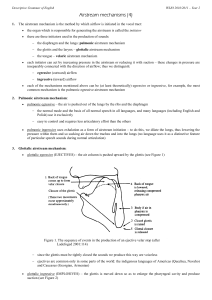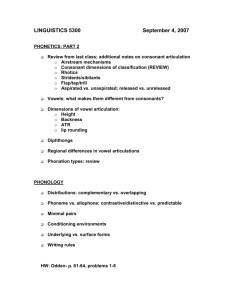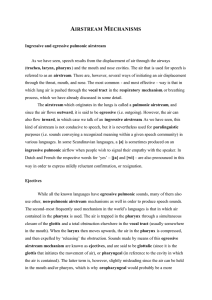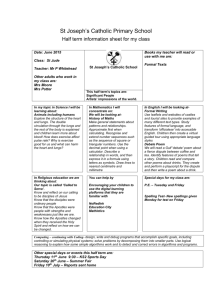Airstream mechanisms and phonation types.
advertisement
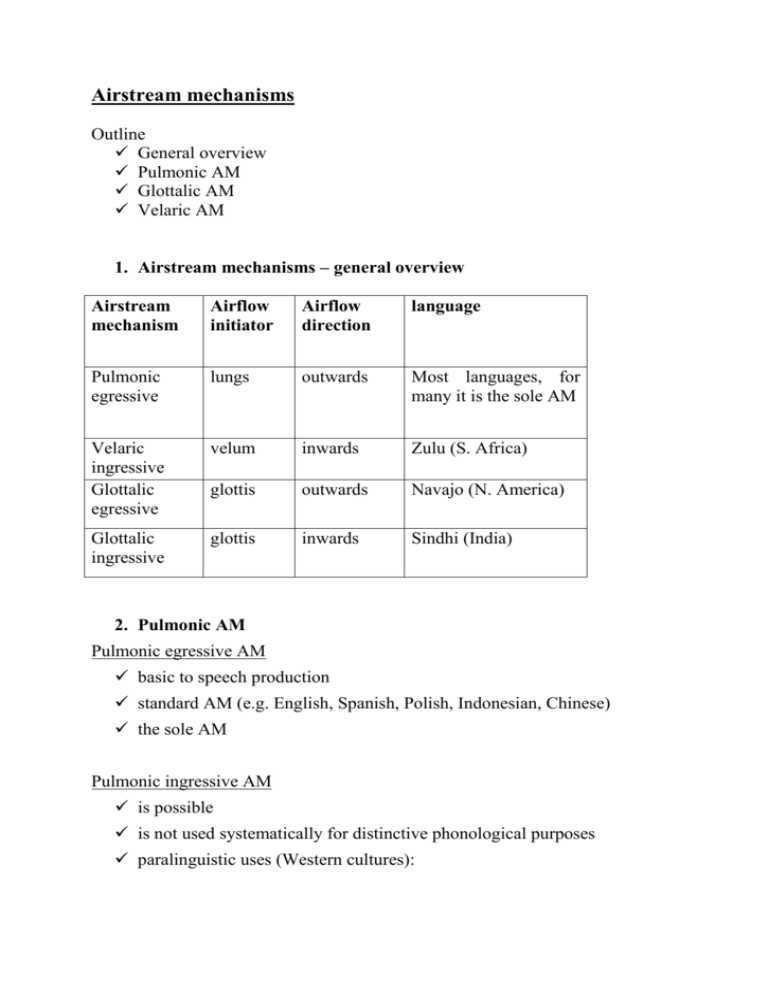
Airstream mechanisms Outline General overview Pulmonic AM Glottalic AM Velaric AM 1. Airstream mechanisms – general overview Airstream mechanism Airflow initiator Airflow direction language Pulmonic egressive lungs outwards Most languages, for many it is the sole AM Velaric ingressive Glottalic egressive velum inwards Zulu (S. Africa) glottis outwards Navajo (N. America) Glottalic ingressive glottis inwards Sindhi (India) 2. Pulmonic AM Pulmonic egressive AM basic to speech production standard AM (e.g. English, Spanish, Polish, Indonesian, Chinese) the sole AM Pulmonic ingressive AM is possible is not used systematically for distinctive phonological purposes paralinguistic uses (Western cultures): - [ja] in Norwegian and Danish commiseration – sympathy, agreement or - [nei] – surprise (Norwegian and Danish), sympathy (Danish) 2.1 Pulmonic egressive AM the outward-flowing airstream is generated by the respiratory system - inspiration – an active process - expiration – a passive process it is easier to control comparing to other AM it requires less overall articulatory effort Schematic diagram showing the inhalation and exhalation phase of breathing. Inhalation: diaphragm and intercostal muscles contract and the lungs expand as well as the air inside them (a gas will always fill its container) the air pressure in the lungs drops the air in the lungs is at a lower pressure than the air outside the air flows into the lungs from outside (the air flows always from higher to lower pressure) Exhalation: a passive process because – it does not involve muscle contraction relaxation of diaphragm and intercostal muscles lungs recoil elastically and reduce their volume the volume of air in the lungs decreases and the air pressure increases the air in the lungs is at a higher pressure than the air outside the air flows out of the lungs the lungs recoil, the diaphragm is pulled up and the ribcage moves downward 2.2 Different activity of the respiratory system breathing - about 12 inspirations and expirations per minute - expiration phase only slightly longer - inspiration involves muscular action (active process) - expiration uses mechanical and elastic recoil force (passive process) speech - expiration phase much longer - expiration is a controlled process with co-activation of the inspiratory and expiratory muscles 3. Glottalic AM It uses the air above the glottis. The airflow is initiated by an upward or downward movement of the larynx controlled by elevator and depressor laryngeal muscles: upward movement – egressive AM – ejectives downward movement – ingressive AM – implosives 3.1 Ejectives include stops, fricatives and affricates they precede or follow sounds using pulmonic AM Schematic representation of pronunciation of a glottalic egressive velar stop [k’]. Ejectives are found in languages of: Africa (Hausa), North (Montana Salish, Lakhota, Navajo), Central (K’ekchi) and South America Asia (mainly in the Caucasus area: Georgian and Circassian) Sound examples: http://www.yorku.ca/earmstro/ipa/nonpulmonics.html 3.2 Implosives realized with incomplete closure of the glottis – there is some voicing voiceless implosives – extremely rare (found only in two languages) include only oral stops implosives are found in languages of Africa (Zulu, Hausa, Margi), Asia (Sindhi) and America (Maidu) The estimated sequence of events in a Sindhi glottalic bilabial implosive [б]. 4. Velaric AM generated entirely within oral cavity 2 closures – double articulation: - the back of the tongue – velum - anterior closure – the lips, the tip, blade or front of the tongue only ingressive airflow cliks – stops and affricates phonological distinctions – rather uncommon (African languages Angola, Botswana, Namibia, Tanzania) of paralinguistic uses of cliks: tsk, tsk signalling impatience or exasperation 2 closures are formed: 1. the tip of the tongue is pressed against the upper teeth, 2. the back of the tongue forms velic closure the back of the tongue moves backwards and downwards the slope of the roof of the mouth, the velic closure is kept the closure in the front of the mouth is released Schematic representation of pronunciation of a velar ingressive voiceless dental [k].
